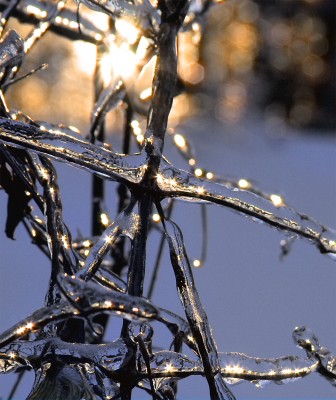HDR Ice Storm
We got one heck of an ice storm in Cincinnati this past week. Actually, these things are getting to be a regular occurance around here in the winter. Must be global warming or some such thing :p
Anyway, as much as I hate the cold, and as much as I hate the way Cincinnati people drive in the winter, ice storms do have an upside – they make for some great photography. There is something really cool about things that are entirely encased in ice, like the clematis in my backyard (left). Photographing clear objects (like ice or glass, etc) comes with a unique set of problems. Namely, they are transparent.
Obviously you and I can see things like ice and glass in the real world. So why don”t they look the same on camera? It”s largely due to motion – as we move around a transparent object, we see light reflections from different angles. Our brains integrate these different views to create a mental image of the ice or glass, etc which is considerably different from the instantaneous image that our eye sees. Cameras, for better or worse, do not have the advantage of a brain. They capture the image exactly the way your eye sees it, without the benefit of additional knowledge about how transparent objects behave.
The result of all this is that most photos of transparent objects either can”t be seen, or are covered in glare. But the way your brain thinks a transparent object should look is more like the photo of the ice above. So what”s the difference? Notice where the highlights are located on the vines (and where they aren”t). When photographing a transparent object, the light must either come from only the edges, or only the center. If you have even lighting, you will not see the ice. If you have a large lightsource behind you, you will only see glare. In the case of the above photo, the sun was above the ice that I wanted to photograph, and it was blocked out of the bottom half of the image by a hill behind the vines – the sunlight could only hit the very top edges of the ice, and as a result the ice is well defined.
I know, the sun”s reflections show up at the bottom edge of the ice, but that”s due to the refractive index of a thick piece of ice. Trust me, the light is hitting the top edge of the ice, and that”s why you can see the edge. You”ll probably also notice that I took a photo of the sun, which is normally way to bright to show up in a photo without completely washing out the foreground. I accomplished this using Auto Exposure Bracketing (a standard feature of most SLRs) and combining the three resulting exposures with Photomatix Pro, a program for creating HDR (high dynamic range) images. More on HDR later, but suffice it to say that it allows you to capture a larger range of contrast than standard images (in much the same way that your eye interprets a scene with very high contrast).
Oh, and in case you”re curious, the hexagonal spots in the upper right of this image are lens flare. Usually lens flare is a bad thing, but personally I like it in some images. The same thing causes the shiny beams from the sun and the sun reflections (usually a good thing), though many photographers would consider any lens flare large enough to create a defined hexagon to be bad. It”s a personal thing though – I don”t think it detracts from the photo in this case, and if anything it reinforces just how bright that sun was.




Leave a Reply